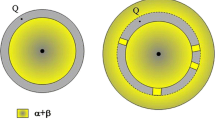Abstract
Analytical model for isochronal phase transformation kinetics attracts much attention for its advantages and importance. However, the simple but exact analytical formula of the isochronal transformation is unavailable because of the so-called temperature integral, and the asymptotic expansions have to be adopted to obtain approximate results. Here a generally used asymptotic expansion was proved divergent, and a reasonable approximation was proposed to obtain a more precise description as compared numerically to the previous one. Based on the proposed approximation, an analytical model for isochronal transformation kinetics was developed, which was proved more effective than the previous analytical model when the transformation occurs in a narrow temperature range and exhibited an identical form to the previous model when in a wide temperature interval.



Similar content being viewed by others
References
Michaelsen C, Dahms M (1996) Thermochim Acta 288:9. doi:https://doi.org/10.1016/S0040-6031(96)03039-0
Kempen ATW, Sommer F, Mittemeijer EJ (2002) Acta Mater 50:1319. doi:https://doi.org/10.1016/S1359-6454(01)00428-1
Liu F, Sommer F, Mittemeijer EJ (2004) Acta Mater 52:3207. doi:https://doi.org/10.1016/j.actamat.2004.03.020
Avrami M (1939) J Chem Phys 7:1103. doi:https://doi.org/10.1063/1.1750380
Avrami M (1940) J Chem Phys 8:212. doi:https://doi.org/10.1063/1.1750631
Avrami M (1941) J Chem Phys 9:177. doi:https://doi.org/10.1063/1.1750872
Johnson WA, Mehl RF (1939) Trans AIME 135:416
Kolmogorov AN (1937) Izv Akad Nauk SSSR, Ser Matem 3:355
Mittemeijer EJ (1992) J Mater Sci 27:3977. doi:https://doi.org/10.1007/BF01105093
Starink MJ (2003) Thermochim Acta 404:163. doi:https://doi.org/10.1016/S0040-6031(03)00144-8
Lyon RE (1997) Thermochim Acta 297:117. doi:https://doi.org/10.1016/S0040-6031(97)00158-5
Vázquez J, Wagner C, Villares P, Jiménez-Garay R (1996) Acta Mater 44:4807. doi:https://doi.org/10.1016/S1359-6454(96)00127-9
Vázquez J, García-G.Barreda D, López-Alemany PL, Villares P, Jiménez-Garay R (2006) Mater Chem Phys 96:107. doi:https://doi.org/10.1016/j.matchemphys.2005.06.050
Ruitenberg G, Woldt E, Petford-Long AK (2001) Thermochim Acta 378:97. doi:https://doi.org/10.1016/S0040-6031(01)00584-6
Kempen ATW, Sommer F, Mittemeijer EJ (2002) J Mater Sci 37:1321. doi:https://doi.org/10.1023/A:1014556109351
Liu F, Sommer F, Mittemeijer EJ (2004) J Mater Sci 39:1621. doi:https://doi.org/10.1023/B:JMSC.0000016161.79365.69
Farjas J, Roura P (2006) Acta Mater 54:5573. doi:https://doi.org/10.1016/j.actamat.2006.07.037
Kempen ATW, Sommer F, Mittemeijer EJ (2002) Acta Mater 50:3545. doi:https://doi.org/10.1016/S1359-6454(02)00149-0
Liu F, Sommer F, Mittemeijer EJ (2007) J Mater Sci 42:573. doi:https://doi.org/10.1007/s10853-006-0802-4
Pineda E, Crespo D (1999) Phys Rev B 60:3104. doi:https://doi.org/10.1103/PhysRevB.60.3104
Kooi BJ (2004) Phys Rev B 70:224108. doi:https://doi.org/10.1103/PhysRevB.70.224108
Kooi BJ (2006) Phys Rev B 73:054103. doi:https://doi.org/10.1103/PhysRevB.73.054103
Borrego A, González-Docel G (1998) Mater Sci Eng A 245:10. doi:https://doi.org/10.1016/S0921-5093(97)00706-5
Varschavsky A, Donoso E (2003) Mater Lett 57:1266. doi:https://doi.org/10.1016/S0167-577X(02)00970-9
Claudio D, Gonzalez-Hernandez J, Licea O, Laine B, Prokhorov E, Trapaga G (2006) J Non-Cryst Solids 352:51. doi:https://doi.org/10.1016/j.jnoncrysol.2005.11.007
Vyazovkin S, Dollimore D (1996) J Chem Inf Comput Sci 36:42. doi:https://doi.org/10.1021/ci950062m
Henderson DW (1979) J Non-Cryst Solids 30:301. doi:https://doi.org/10.1016/0022-3093(79)90169-8
Henderson DW (1979) J Thermal Anal 15:325. doi:https://doi.org/10.1007/BF01903656
De Bruijn TJW, De Jong WA, Van Den Berg PJ (1981) Thermochim Acta 45:315. doi:https://doi.org/10.1016/0040-6031(81)85091-5
Málek J (1995) Thermochim Acta 267:61. doi:https://doi.org/10.1016/0040-6031(95)02466-2
Apostol Tom M (1974) Mathematical analysis, 2nd edn, Chaps. 8 and 9. Addison-Wesley
Acknowledgements
The authors are grateful to the National Natural Science Foundation of China (No. 50401003), the Natural Science Foundation of Tianjin City (No. 07JCZDJC01200), Fok Ying Tong Education Foundation and Program for New Century Excellent Talents in University for grant and financial support.
Author information
Authors and Affiliations
Corresponding author
Appendix A: Deducing the expression for the isochronal transformation kinetics model
Appendix A: Deducing the expression for the isochronal transformation kinetics model
The extend volume Eq. 12 can be calculated upon Eq. 22:
The power term in (A1) can be expanded as binomial series [14, 31]:
where \(\left(\begin{array}{l} d/m\\ i\\ \end{array}\right)=\frac{\prod\limits_{j=0}^{i-1}\left((d/m)-j\right)} {i!}, \left(\begin{array}{l} d/m\\ 0\\ \end{array}\right)=1, \) is the binomial coefficients. Then the integral (A1) can be calculated as:
where
For the interface-controlled growth, d/m is integer, the binomial coefficients would be truncated at i = d/m, and then (A2) becomes:
For the diffusion-controlled growth, d/m is semi-integer except d/m = 2/2, and then ψ(T0, T(t), d/m) has infinite terms. However, ψ(T0, T(t), d/m) converges quickly [14]. Therefore, a reasonable approximation can be available by truncating at the primary terms. The expressions for ψ(T0, T(t), d/m) are given in Table 1.
Rights and permissions
About this article
Cite this article
Wang, D., Liu, Y. & Zhang, Y. Improved analytical model for isochronal transformation kinetics. J Mater Sci 43, 4876–4885 (2008). https://doi.org/10.1007/s10853-008-2709-8
Received:
Accepted:
Published:
Issue Date:
DOI: https://doi.org/10.1007/s10853-008-2709-8




